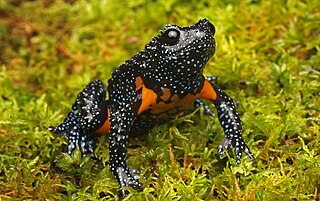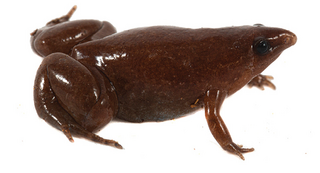
Tomato frogs are any of the three species of genus Dyscophus : D. antongilii, D. insularis, or D. guineti. Dyscophus is the only genus in subfamily Dyscophinae. They are endemic to Madagascar.

Cophylinae is a subfamily of microhylid frogs endemic to Madagascar. It has over 100 species in eight genera. Members of this subfamily range from minute to fairly large, and they are highly ecologically diverse. DNA barcode research has revealed a significant taxonomic gap in this subfamily, and an estimated 70+ candidate species were identified. Many of these have subsequently been described, as well as numerous new discoveries.

Anodonthyla is a genus of microhylid frogs endemic to Madagascar. Molecular data suggest that it is the sister taxon to all other species in the subfamily Cophylinae.

Plethodontohyla is a genus of microhylid frogs endemic to Madagascar.

Stumpffia is a genus of microhylid frogs that are endemic to Madagascar. They are mostly brown frogs that typically live among leaf litter. S. contumelia has a snout–vent length of about 8–9 mm (0.31–0.35 in), making it one of the world's smallest frogs, and several others in the genus are only slightly larger. The largest species is no more than 28 mm (1.1 in).

Barygenys is a genus of microhylid frogs. They are endemic to New Guinea and the adjacent Louisiade Archipelago. So far only known from Papua New Guinea, the range of the genus is expected to reach Papua province in the Indonesian part of New Guinea. Despite not being known from Papua, common name Papua frogs has been suggested for them.
Callulops is a genus of microhylid frogs from Sulawesi as well as the New Guinea region, from Talaud Islands and the Maluku Islands (Moluccas) in the northwest to the Louisiade Archipelago in the east. They are medium- to large-sized terrestrial frogs inhabiting burrows on the forest floor, often under large rocks. Because their population densities can be low, and they are difficult to observe and collect owing to their lifestyle, many species are known only from few specimens.
Hoplophryne is a genus of microhylid frogs. The genus is endemic to mountain forests of Tanzania. They are also known as three-fingered frogs or African banana frogs.

Otophryne is a small genus of microhylid frogs from northern South America. They are sometimes known as the pancake frogs.

Stereocyclops is a small genus of microhylid frogs. It is endemic to the Atlantic forest of eastern Brazil. Molecular phylogeny suggests that it is sister taxon to the clade containing Dasypops and Myersiella.

Melanobatrachus is a genus of narrow-mouthed frogs in the family Microhylidae. It is the only remaining genus in the monotypic subfamily Melanobatrachinae. It contains a single species, Melanobatrachus indicus, also known as the Indian black microhylid frog and Malabar black narrow-mouthed frog. It is endemic to wet evergreen forests of southern Western Ghats in Kerala and Tamil Nadu states of India. It has been recorded from Anaimalai, Munnar, Palni hills, Periyar Tiger Reserve and Kalakkad Mundanthurai Tiger Reserve
Arcovomer is a genus of frogs in the family Microhylidae. It is monotypic, being represented by the single species Arcovomer passarellii, commonly known as Passarelli's frog. It is endemic to south-eastern Brazil and found in Espírito Santo, Rio de Janeiro, and São Paulo states. Frogs from Espírito Santo may represent another, undescribed species. The name honours Antonio Passarelli who collected the holotype.

Copiula guttata is a species of frog in the family Microhylidae. It is endemic to Papua New Guinea and known from around the head of the Gulf of Papua in the Gulf and Chimbu Provinces. The specific name is the Latin adjective guttata that means "spotted" and refers to the dorsal colour pattern of this species. Based on molecular evidence, it was transferred from Austrochaperina to Copiula in 2016.
Barygenys exsul is a species of frog in the family Microhylidae. It is endemic to Papua New Guinea. It is known from Rossel and Sudest Islands in the Louisiade Archipelago, east of New Guinea. It is uncertain whether the specimens from Sudest really are conspecific with this species. Barygenys apodasta and Barygenys resima were mixed with this species prior to their description in 2013.

Myersiella is a genus of frogs in the family Microhylidae. It is monotypic, being represented by the single species, Myersiella microps. It is endemic to southeastern Brazil and occurs in Espírito Santo, Rio de Janeiro, southeastern Minas Gerais, and southeastern São Paulo state. The genus name honors George S. Myers. The genus is sometimes known as the elongated frogs, while the sole species is known as Rio elongated frog.
Xenorhina zweifeli is a species of frog in the family Microhylidae. It is endemic to New Guinea and is only known from the Bewani and Hunstein Mountains in northern Papua New Guinea. The species is named for American herpetologist Richard G. Zweifel, a specialist in New Guinean herpetology and microhylid frogs; he is also said to share "characteristically terse vocalizations" with this frog.

Microhyla fissipes is a microhylid frog from East and Southeast Asia, from southern and central China and Taiwan to the Malay Peninsula. It was previously considered to be the same species as Microhyla ornata of South Asia; thus the common names ornate narrow-mouthed frog or ornamented pygmy frog can refer to either species.

Rhombophryne serratopalpebrosa is a species of frog of the Madagascar endemic microhylid subfamily Cophylinae. Genetic evidence revealed that it is a species complex, in need of resolution. This work has made significant progress, and five related species have been described from this complex between 2014 and 2017. It is threatened by habitat loss.

Synapturanus danta is a species of frog from the family Microhylidae that was described in 2022. It has an enlarged nose like that of a tapir, giving it the common name tapir frog.
Synapturanus ajuricaba is a species of microhylid frog. It is endemic to the state of Para in Brazil.














